| The Painter of "Diana of the Tides" | ||
The Painter of "Diana of the Tides"
By WALTER PRICHARD EATON
Author of "The American Stage of To-day," etc.
GIVEN nearly three hundred square feet of blank wall space, and it takes something of an artist to fill it up with interesting paint. Probably you would not pick a miniature painter for the task. Yet, curiously, John Elliott, creator of "Diana of the Tides," the great mural painting which adorns the large gallery to the right of the entrance of the new National Museum at Washington, also paints on ivory. He works, likewise, in silver point, that delicate and difficult medium; he draws pastel illustrations for children's fairy tales; he works in portraiture with red chalk or oils. And, when the need comes, he has shown that he can turn stevedore, carpenter, and architect, to slave with the relief party at Messina, finally to help design and build, in four months, an entire village for the stricken sufferers, including a hotel, a hospital, three schoolhouses, and a church. The too frequent scorn of the "practical man of affairs" for the artist and dreamer, the world's sneaking tolerance for the temperament which creates in forms of ideal beauty rather than in bridges or factories or banks, finds in the life and work of such a man as John Elliott such complete, if unconscious, refutation, that his story should have its place in the history of the day.
John Elliott was born on Good Friday, 1859, one of a famous Scottish border family. His residence is now in Boston, Massachusetts, at the home of his mother-in-law. Mrs. Julia Ward Howe. Robert Louis Stevenson had Elliott blood in his veins. "Parts of me," he once wrote, "have shouted the slogan of the Elliotts in the debatable land." If Stevenson's Homeric account of the Four Black Elliotts in "Weir of Hermiston" is historically veracious, we might fancy that one of their descendants would feel his activities somewhat cramped on Beacon Street, Boston. The Elliotts were a wild lot, and some of them did not escape the hangman. Their family tree appears to have been the gallows. But Stevenson tells us they were noted for their prayers, and at least one of them wrote poetry, and declaimed it, drunk, to Walter Scott, who retaliated in kind.
But the present John Elliott, artist, though he is of the kin of Stevenson, and bears the dark hair and rather prominent, melancholy eyes of the traditional Elliott stock, yet physically much more closely resembles Edgar Allan Poe. If you press him hard, he will confess that he began life by studying for the stage, and "almost played Romeo," before painting drew him away. Reaching Italy, he aspired to enter the studio of Don José di Villegas, now director of the Prado Museum in Madrid, but then in Rome. Villegas took no pupils. But "Jack" Elliott is Scotch. He made a bargain. He would teach the master English, in return for instruction in painting. At the end of two years, young Elliott had learned much about art, but the master, he says, had acquired only one English phrase—"I haf no money!"
At the end of two years, Elliott wished to leave, because he despaired of painting like his master. "That is why I keep you," said Villegas; "you have retained your own manner and choice of subjects." So the pupil stayed on in Rome for five years, sharing his studio later with Aristide Sartorio, now a leading Italian painter. Here, in the Via Flaminia, he painted his first important mural decoration, for the dining room of Mrs. Potter Palmer's Chicago Lake Shore mansion. This work, called "The Vintage," is decorously inebriate, a vinous riot of little cupids. It led, shortly after his marriage in 1887 to Miss Maud Howe, a daughter of Mrs. Julia Ward Howe, to his establishing himself in Chicago, where he did many decorations and portraits. In 1894, he went back to Rome to execute a commission for a huge ceiling piece for the Boston Public Library. The piece was for a room later converted into a children's room, and after the canvas was placed, in 1901, the incongruity of the adult painting and the purposes of the room caused unfavorable comment. But the room has been recently readjusted. It is now lined with high
This ceiling, fifty feet square, divided into two equal panels, represents the twenty Christian centuries, as horses, led by the hours (winged female figures) out of the mists of the past into the illumination of the present. The models for the horses were the undersized nags of the Roman Campagna, which are "small but decorative beasties," as Mr. Elliott puts it, and lend themselves to a slightly conventional treatment. They sweep two by two, out of a cool mistiness, round the ceiling past the suggestion of a pale moon, into the full radiance of the golden orb of the sun. The triumph of the picture is its handling of the problem of light. This golden daybreak pierces the mists whereon the horses gallop, touches here a flank, there a wing feather on one of the hours, and warms to rosy glow the tip of a cloud. It appears in unexpected places, grows where only shadow seemed to be, and surprises you anew each time you look up. Painted in the flat—that is, with no part of the picture telling as farther from the eye than another, to distort the proportions of the room—the ceiling yet has great depth, distance, airy lightness. It is a true decorative painting.
While at work upon it, Mr. Elliott painted many portraits, including the well-known red chalk heads of the "Soldiers Three," Lord Ava, the Marquis of Winchester, and General Wauchope; the portrait of His Royal Highness the Duke of Cambridge; and that of Lady Katherine Thynne, now Lady Cromer, a celebrated English beauty. Indeed, he made her the model for the second hour in the Boston ceiling, the figure next to the leader in the procession. Three studies of her head for this figure, well known from reproduction, are now in the possession of Thomas W. Lawson.
In Rome the Elliotts occupied for some time the apartments of Mrs. Elliott's cousin, the late F. Marion Crawford, in the Palazzo Santa Croce. In writing "With the Immortals," Mr. Crawford had collected many death masks, including one of Dante, which fascinated Mr. Elliott. Two pictures of "Dante in Exile" were the result. One of them now hangs in the living room of Queen Margherita of Italy, the other in the house of Mrs. J. Montgomery Sears of Boston. A third pastel study was made, an unfinished head of the poet, and thrown into a wastebasket. By a curious fatality, it is now better known than either of the paintings. Mrs. Elliott rescued the drawing, smoothed it out, framed it, and was allowed to hang it in her chamber. Later it was seen and purchased by Mrs. David Kimball of Boston, and in reproduction has gone all over the world, receiving honors in Japan and the higher honor of a place over the desk of many Dante students. Yet few who possess the reproduction know anything of the artist.
Mr. Elliott, receiving his commission to do a great mural painting for the new National Museum in Washington, again went to Rome four years ago. "Diana of the Tides" was completed and signed on Christmas day, 1908. Three days later came the awful news of the Messina earthquake, and the Hon. Lloyd Griscom, then American Ambassador to Italy, at once called for volunteers for his relief expedition. John Elliott was among the first to respond. He went south officially as an interpreter. Actually, he played the part of stevedore as well for ten days on the relief ship.
"I have dropped my last knuckle down the hold this morning," he wrote back, "and I have only two fingers left that I can wash."
After a few weeks, he hastened back to Rome, to give a promised public exhibition of "Diana of the Tides," and, as soon as the exhibition was over, rushed down to Messina again.
There Commander Belknap, who was at the head of the American relief forces, put him to work, as architect, on the erection of the American village, in the lemon groves on the outskirts of the stricken city. "I had never been trained as an architect," he says, "but I once made over a house up in Cornish, New Hampshire, and that gave me a practical experience which came in remarkably handy."
Most of the lumber had been cut for the erection of small houses, and the door and window frames were stock pieces. It became his task to design and build, as quickly as could be done, not only comfortable houses for many thousand people, but a church, a hotel, three schools, a hospital, all out of these small lumber units. He combined the units for the larger buildings, so grouping the small stock window frames as to give a pleasing effect of size, even constructing a kind of rose window for the church. He helped lay out the streets in such a way as to preserve all the trees possible. And, in spite of the haste
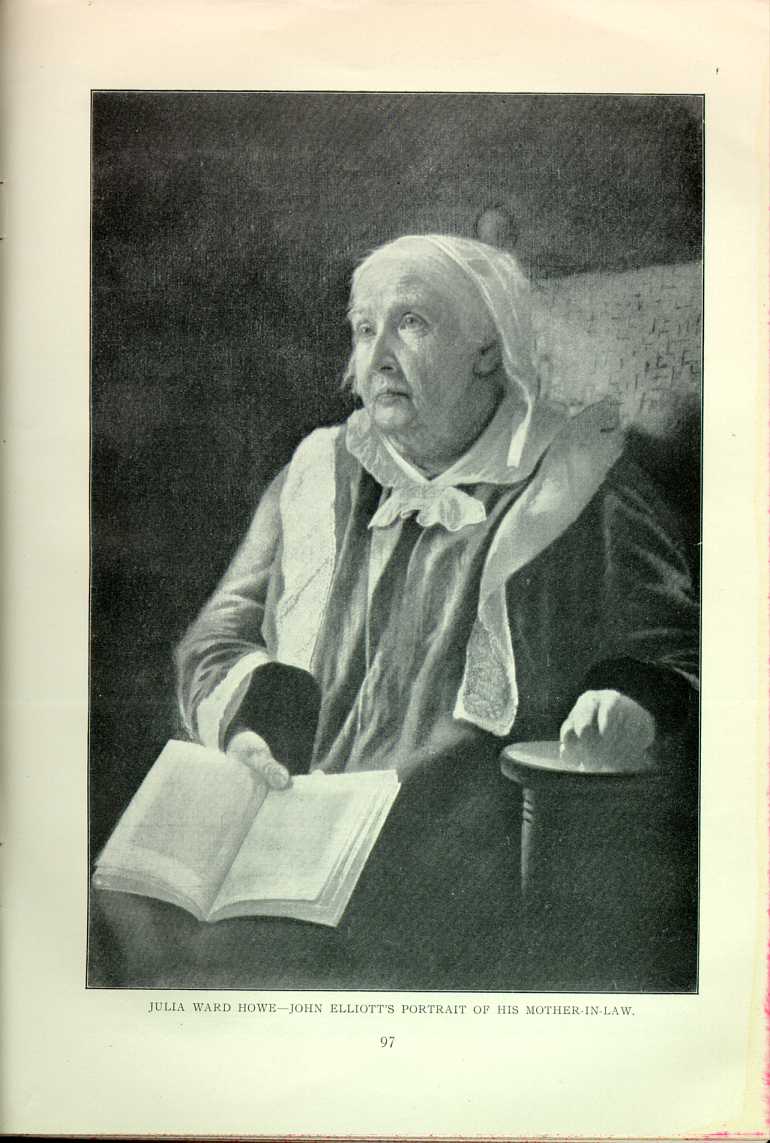
JULIA WARD HOWE—JOHN ELLIOTT'S PORTRAIT OF HIS MOTHER-IN-LAW.
[Description: Portrait of older woman, seated, holding open book. Black and white reproduction. Original painting by John Elliot. ]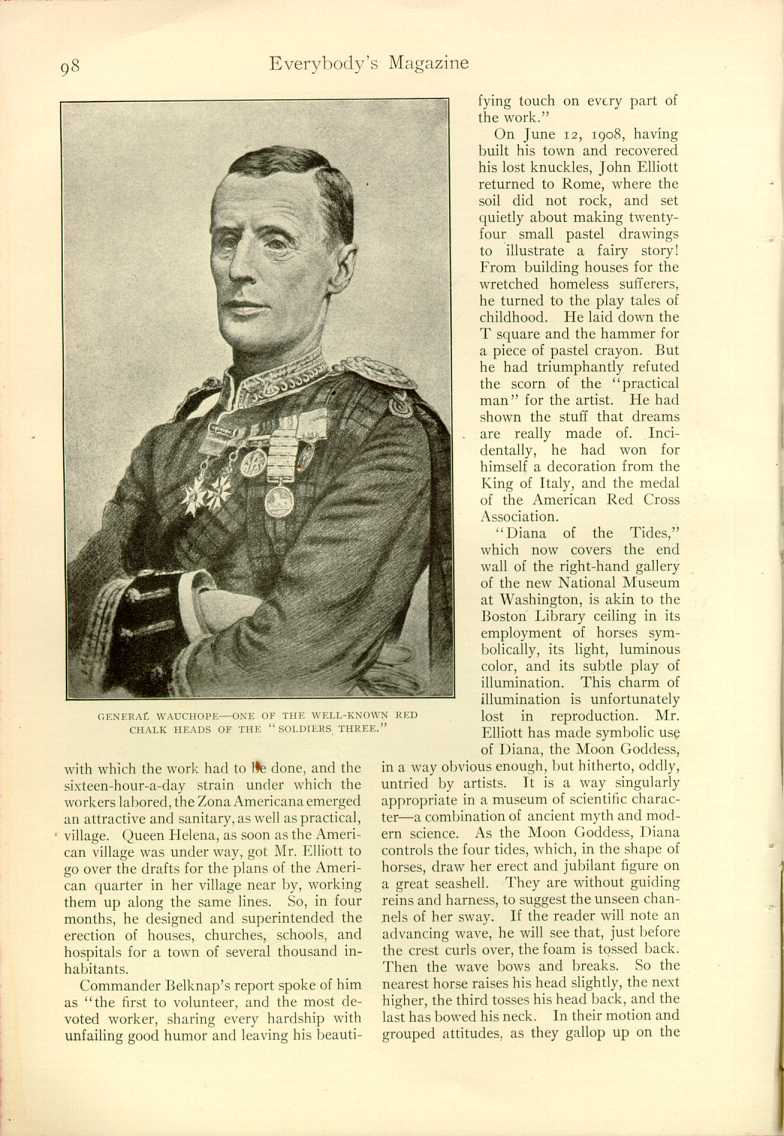
GENERAL WAUCHOPH—ONE OF THE WELL-KNOWN RED CHALK HEADS OF THE "SOLDIERS THREE."
[Description: Portrait of General, in uniform decorated with medals. Black and white reproduction. Original by John Elliot. ]Commander Belknap's report spoke of him as "the first to volunteer, and the most devoted worker, sharing every hardship with unfailing good humor and leaving his beautifying touch on every part of the work."
On June 12, 1908, having built his town and recovered his lost knuckles, John Elliott returned to Rome, where the soil did not rock, and set quietly about making twenty-four small pastel drawings to illustrate a fairy story! From building houses for the wretched homeless sufferers, he turned to the play tales of childhood. He laid down the T square and the hammer for a piece of pastel crayon. But he had triumphantly refuted the scorn of the "practical man" for the artist. He had shown the stuff that dreams are really made of. Incidentally, he had won for himself a decoration from the King of Italy, and the medal of the American Red Cross Association.
"Diana of the Tides," which now covers the end wall of the right-hand gallery of the new National Museum at Washington, is akin to the Boston Library ceiling in its employment of horses symbolically, its light, luminous color, and its subtle play of illumination. This charm of illumination is unfortunately lost in reproduction. Mr. Elliott has made symbolic use of Diana, the Moon Goddess. in a way obvious enough, but hitherto, oddly, untried by artists. It is a way singularly appropriate in a museum of scientific character— a combination of ancient myth and modern science. As the Moon Goddess, Diana controls the four tides, which, in the shape of horses, draw her erect and jubilant figure on a great seashell. They are without guiding reins and harness, to suggest the unseen channels of her sway. If the reader will note an advancing wave, he will see that, just before the crest curls over, the foam is tossed back. Then the wave bows and breaks. So the nearest horse raises his head slightly, the next higher, the third tosses his head back, and the last has bowed his neck. In their motion and grouped attitudes. as they gallop up on the
Diana stands behind the horses, against the great, golden moon—a radiant halo. She has just unloosed an arrow from her bow. Her draperies are of indefinite color, the rose and lilac and amber of sunset. Her face, it will be noted, though she stands against the moon, is lighted from in front. In that fact lies the secret of the illumination. For this picture was supposedly painted at that one Byronic hour of the year when
Turner, in a small water color, has worked
out a similar problem, with the cool copper
of the harvest moonlight bathing one side of
an old stone tower, the warm rose of sunset
the other. In Mr. Elliott's great canvas the
mutual lights kill all shadows, and out toward
the great yellow disk of the moon the invisible
sun floods its lilac and pink, kindling the
waves, the draperies of the goddess, the wet
flanks of the horses, and suffusing the whole
painting with its delicate, bright warmth,
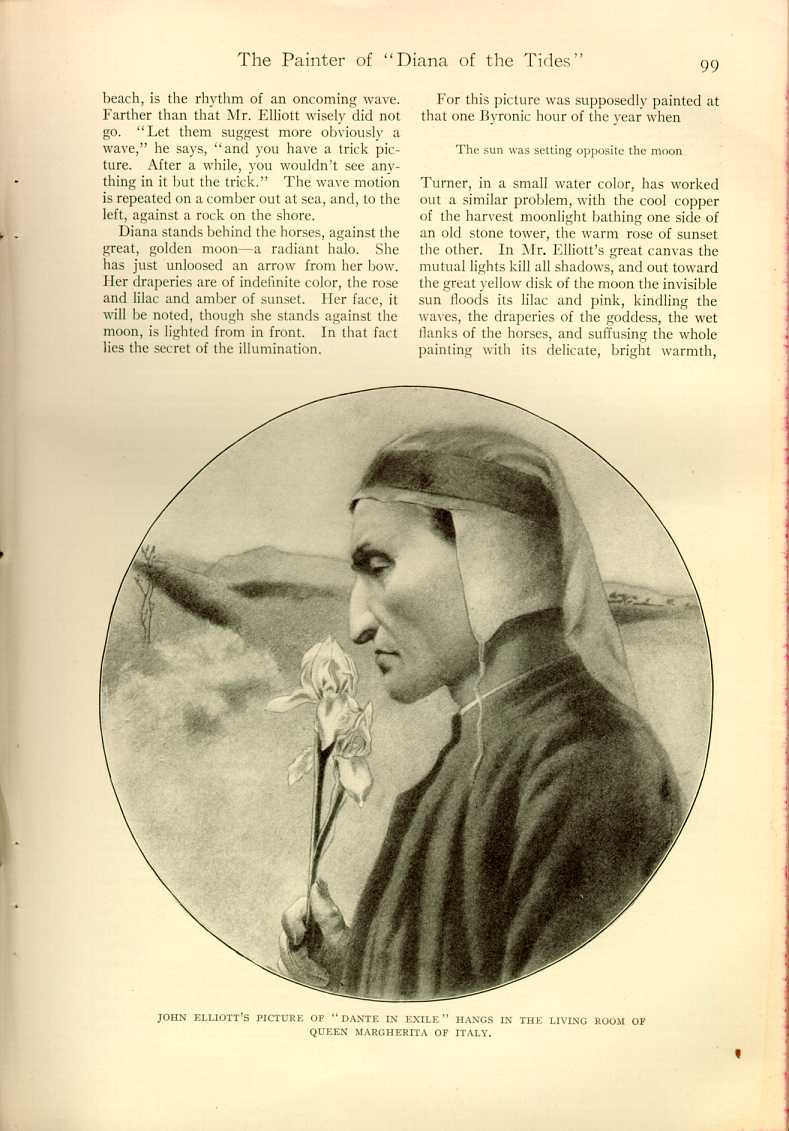
JOHN ELLIOTT'S PICTURE OF "DANTE IN EXILE" HANGS IN THE LIVING
ROOM OF QUEEN MARGHERITA OF ITALY.
[Description: Profile of Dante holding lilies before him.
Black and white reproduction.
Original by John Elliot.
]
While this canvas was being unpacked in
Washington last winter, Mr. Elliott was
exhibiting in Boston his portrait of his mother-in-law,
Mrs. Julia Ward Howe. It was begun
and nearly finished at Newport four or
five years ago; but Mr. Elliott has not cared
to complete it, for during the interval the
"Grand Old Lady" has considerably changed
in appearance. She is now more than ninety
years old. When the sittings began, Mrs.
Howe had just recovered from an illness, and
could read or talk only for brief periods.
Mostly she sat looking out of her window at a
bird which had a nest in a nearby tree. In
this attitude, the eyes raised, the face quiet yet
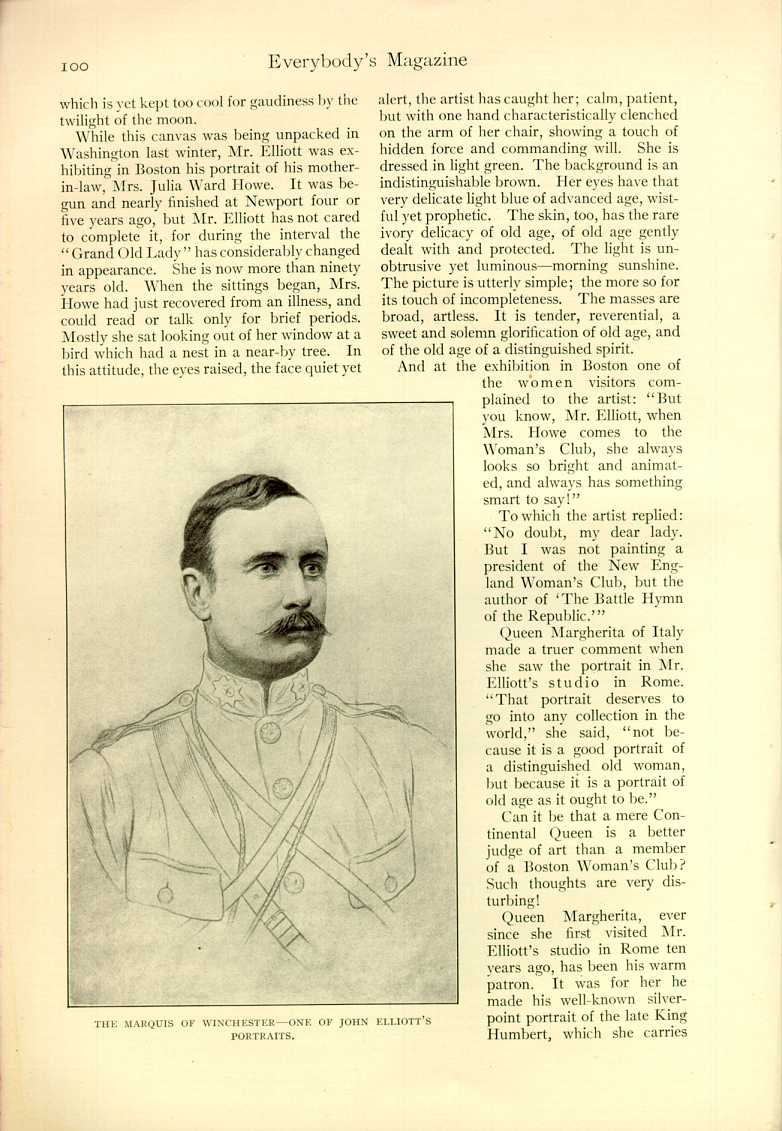
THE MARQUIS OF WINCHESTER—ONE OF JOHN ELLIOT'S
PORTRAITS.
[Description: Portrait of the Marquis in military attire.
Black and white reproduction.
Original by John Elliot.
]
And at the exhibition in Boston one of the women visitors complained to the artist: "But you know, Mr. Elliott, when Mrs. Howe comes to the Woman's Club, she always looks so bright and animated, and always has something smart to say!"
To which the artist replied: "No doubt, my dear lady. But I was not painting a president of the New England Woman's Club, but the author of `The Battle Hymn of the Republic.' "
Queen Margherita of Italy made a truer comment when she saw the portrait in Mr. Elliott's studio in Rome. "That portrait deserves to go into any collection in the world," she said, "not because it is a good portrait of a distinguished old woman, but because it is a portrait of old age as it ought to be."
Can it be that a mere Continental Queen is a better judge of art than a member of a Boston Woman's Club? Such thoughts are very disturbing!
Queen Margherita, ever since she first visited Mr. Elliott's studio in Rome ten years ago, has been his warm patron. It was for her he made his well known silver-point portrait of the late King Humbert, which she carries
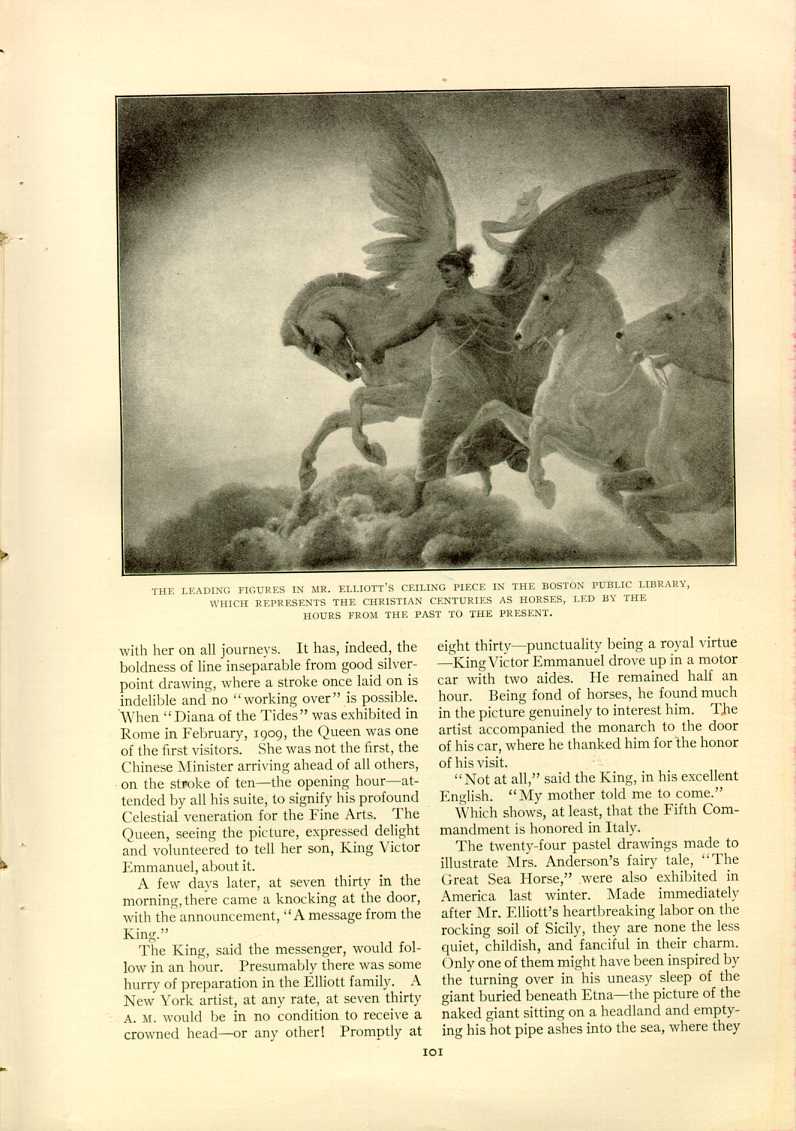
THE LEADING FIGURES IN MR. ELLIOTT'S CEILING PIECE IN THE BOSTON PUBLIC LIBRARY, WHICH REPRESENTS THE CHRISTIAN CENTURIES AS HORSES, LED BY THE HOURS FROM THE PAST TO THE PRESENT.
[Description: Winged female figure leads three prancing horses through clouds suffused with light. Black and white reproduction of portion of original. Original painting by John Elliot. ]A few days later, at seven thirty in the morning, there came a knocking at the door, with the announcement, "A message from the King."
The King, said the messenger, would follow in an hour. Presumably there was some hurry of preparation in the Elliott family. A New York artist, at any rate, at seven thirty A. M. would be in no condition to receive a crowned head—or any other! Promptly at eight thirty—punctuality being a royal virtue —King Victor Emmanuel drove up in a motor car with two aides. He remained half an hour. Being fond of horses, he found much in the picture genuinely to interest him. The artist accompanied the monarch to the door of his car, where he thanked him for the honor of his visit.
"Not at all," said the King, in his excellent English. "My mother told me to come."
Which shows, at least, that the Fifth Commandment is honored in Italy.
The twenty-four pastel drawings made to illustrate Mrs. Anderson's fairy tale, "The Great Sea Horse," were also exhibited in America last winter. Made immediately after Mr. Elliott's heartbreaking labor on the rocking soil of Sicily, they are none the less quiet, childish, and fanciful in their charm. Only one of them might have been inspired by the turning over in his uneasy sleep of the giant buried beneath Etna—the picture of the naked giant sitting on a headland and emptying his hot pipe ashes into the sea, where they
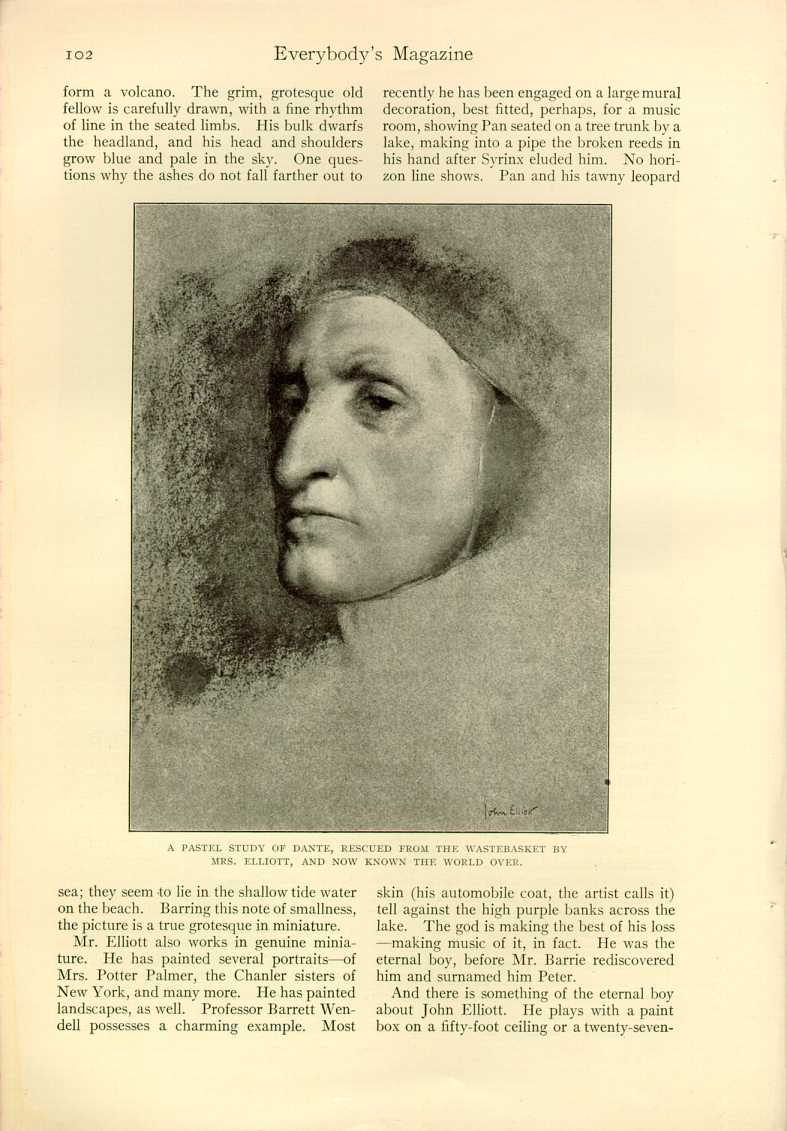
A PASTEL STUDY OF DANTE, RESCUED FROM THE WASTEBASKET BY MRS. ELLIOTT, AND NOW KNOWN THE WORLD OVER.
[Description: Portrait of Dante. Only his face appears clearly. Black and white reproduction. Original by John Elliot. ]Mr. Elliott also works in genuine miniature. He has painted several portraits—of Mrs. Potter Palmer, the Chanler sisters of New York, and many more. He has painted landscapes, as well. Professor Barrett Wendell possesses a charming example. Most recently he has been engaged on a large mural decoration, best fitted, perhaps, for a music room, showing Pan seated on a tree trunk by a lake, making into a pipe the broken reeds in his hand after Syrinx eluded him. No horizon line shows. Pan and his tawny leopard skin (his automobile coat, the artist calls it) tell against the high purple banks across the lake. The god is making the best of his loss —making music of it, in fact. He was the eternal boy, before Mr. Barrie rediscovered him and surnamed him Peter.
And there is something of the eternal boy about John Elliott. He plays with a paint box on a fifty-foot ceiling or a twenty-seven-foot
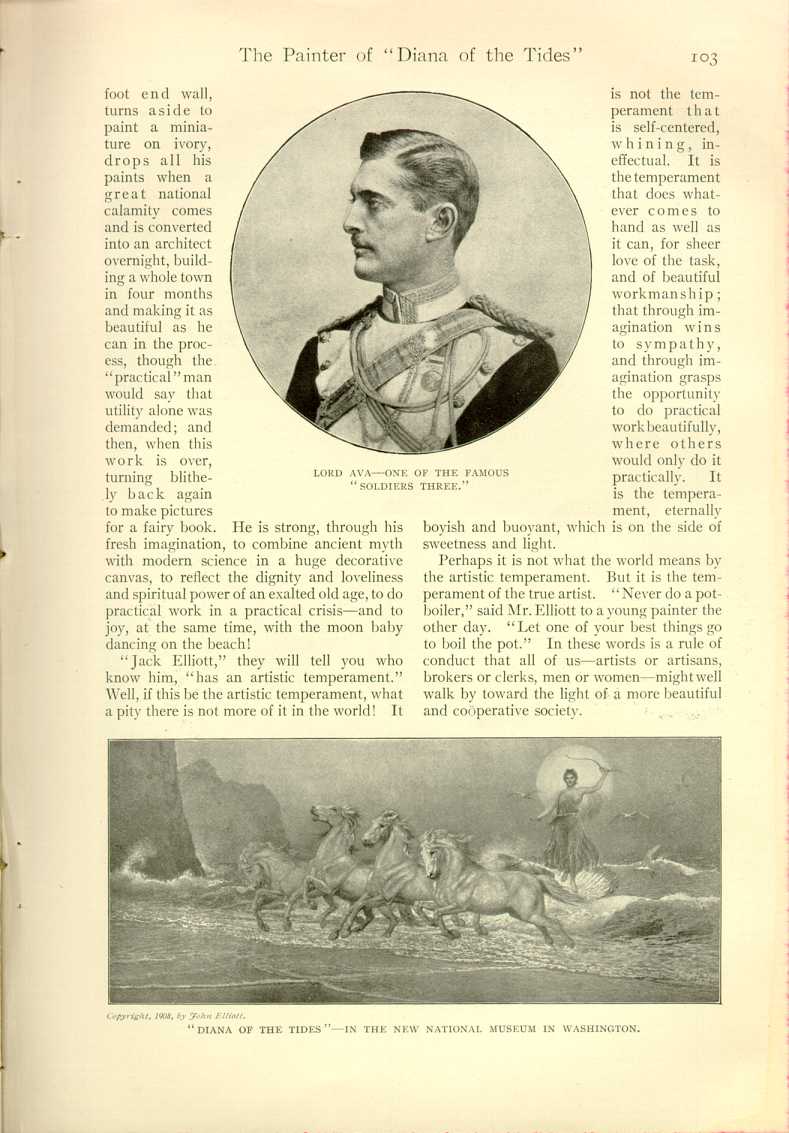
LORD AVA—ONE OF THE FAMOUS "SOLDIERS THREE."
[Description: Portrait of Lord Ava in military attire. Black and white reproduction. Original by John Elliot.]"Jack Elliott," they will tell you who know him, "has an artistic temperament." Well, if this be the artistic temperament, what a pity there is not more of it in the world! It is not the temperament that is self-centered, whining, ineffectual. It is the temperament that does whatever comes to hand as well as it can, for sheer love of the task, and of beautiful workmanship that through imagination wins to sympathy, and through imagination grasps the opportunity to do practical work beautifully, where others would only do it practically. It is the temperament eternally boyish and buoyant, which is on the side of sweetness and light.
Perhaps it is not what the world means by
the artistic temperament. But it is the
temperament of the true artist. "Never do a pot-boiler,"
said Mr. Elliott to a young painter the
other day. "Let one of your best things go
to boil the pot." In these words is a rule of
conduct that all of us—artists or artisans
brokers or clerks, men or women—might well
walk by toward the light of a more beautiful
and coöperative society.
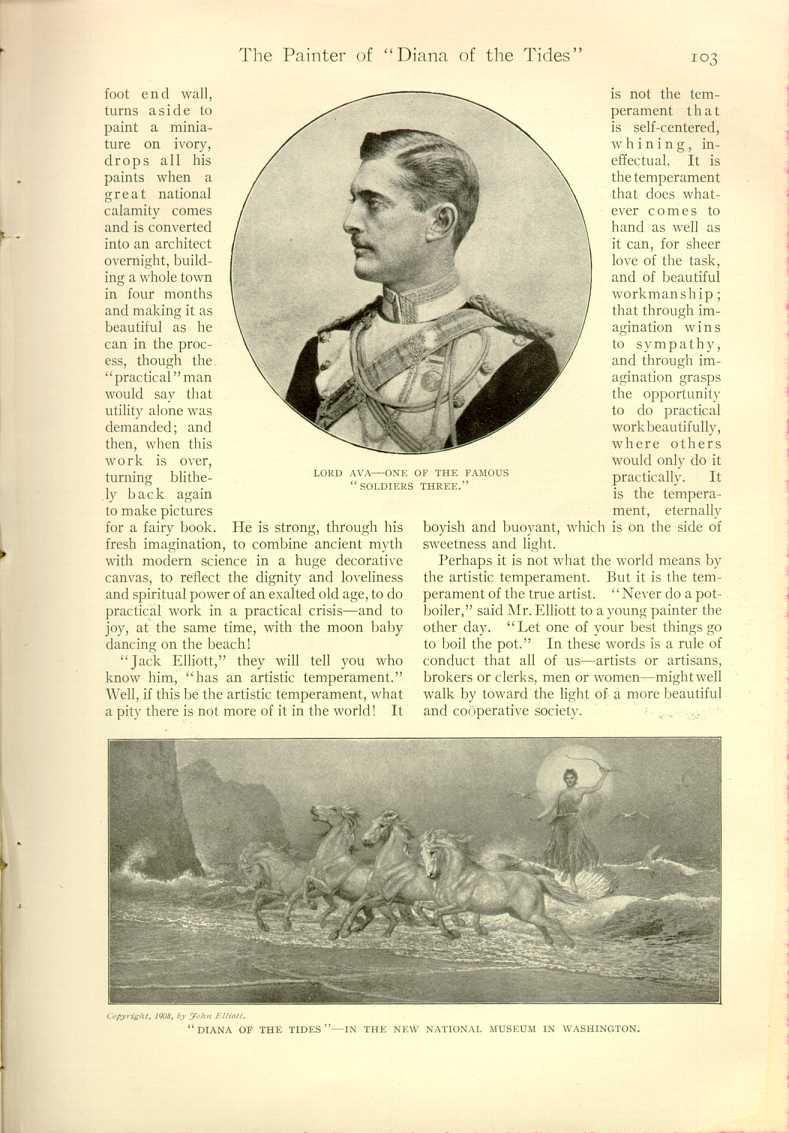
"DIANA OF THE TIDES"—IN THE NEW NATIONAL
MUSEUM IN WASHINGTON.
[Description: The goddess Diana among the waves, backlit by a
full moon, holding her bow aloft.
Four horses gallop before her,
drawing her behind them on a giant seashell.
Black and white reproduction. Original painting by
John Elliot.]
Copyright, 1908, by John Elliot.
| The Painter of "Diana of the Tides" | ||